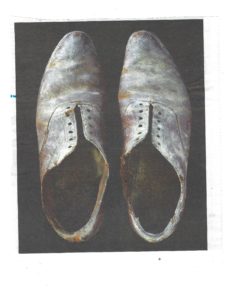This blog covers two of the most unusual aspects of poetry, i.e., the uses of Synesthesia and of non-standard poetic forms, Synesthesia refers to a technique adopted by writers to present ideas, characters, or places in such a way that they appeal to more than one sense, like hearing, sight, smell, and touch at a given time. In everyday language, we find many examples of synesthesia, such as the often used adjective “cool.” This word is generally associated with temperature. However, in casual conversation, we hear phrases like “cool dress,”, “cool color,” or “you look cool,” wherein the poet blends a visual sensation is blended with the sense of touch. Moreover, we commonly hear phrases like “loud colors,” “frozen silence,” “warm colors,” and “bitter cold.” In Dante’s Divine Comedy, he writes, “Back to the region where the sun is silent.” In her book “The World Over,” Julia Glass’s character senses colors in words:“The word would fill her mind for a few minutes with a single color: not an unpleasant sensation, but still an intrusion… she thought, a temple of a word, a shiny red-brown, like the surface of a chestnut.”

In ’ Ode to a Nightingale,’ when John Keats writes “Tasting of Flora and the country green, Dance, and Provencal song, and sun burnt mirth!” he combines visual sensation with those of taste and hearing. He uses other examples of Synesthesia in verse 5:

I cannot see what flowers are at my feet,
Nor what soft incense hangs upon the boughs,
But, in embalmed darkness, guess each sweet
Wherewith the seasonable month endows
The grass, the thicket, and the fruit-tree wild;
White hawthorn, and the pastoral eglantine;
Fast fading violets cover’d up in leaves;
And mid-May’s eldest child,
The coming musk-rose, full of dewy wine,
The murmurous haunt of flies on summer eves
The embalmed darkness, in line 3 above, also unites a liquidity feel with a visual image, creating an eternal type of embalming image. In line 9, he associates the smell and visual look of “musk rose,” with that of the taste of “dewy wine,” thus creating an intoxicating taste, smell, and feel.
Most poetry is shaped in standardized looking lines with words that wrap around in a linear manner. Many poems follow some type of grammar, rhyming patterns, or line structure, such as Shakespeare’s poems. However, in more modern poetry, the above formats are abandoned. For example, Lawrence Schimel’s poem, “Crescent Moon” is shaped like its title:
´Crescent Moon – (Shaped Poem) by Lawrence Schimel
´ The
´ moon
´ is shy.
´ You can
´ find her
´ peeking out
´ at the world
´ from the edge
´ of my fingernails.
´ When I cut them
´ the moon slips
´ out, no bigger
´ than a nail
´ clipping as
´ she hangs
´ up there
´ in the
´ sky.
“Buffalo Bill’s” by Edward Estlin Cummings (e.e. cummings) has no particular shape or rhyming pattern:
´Buffalo Bill’s
´defunct
´ who used to
´ ride a watersmooth-silver
´ stallion
´and break onetwothreefourfive pigeonsjustlikethat
´ Jesus
´he was a handsome man
´ and what i want to know is
´how do you like your blueeyed boy
´Mister Death
I might add that the poem has a measure of alliteration, in its mention of “watersmooth-silver stallions.” In our poetry workshop, some participants, including me, noted the ambiguous placement of “Jesus” in the middle of the poem. Was it an exclamatory term or was the speaker saying that Jesus was a handsome man, asking him, as God’s representative, what he thinks of his own death or the death of Buffalo Bill?
What do you think? Please write me in the dialogue box below, In the next and last installment of my summer Osher Institute Poetry Workshop, I will offer a few of the poems written by the participants. If this series of workshops have inspired you in any way, please send your original poem to me by August 30 at ellisonms2@vcu.edu and I will consider adding it to the next Poetry blog.
Poems from this blog are quoted from the comprehensive www.poetryfoundation.org website. I appreciate what they offer to poets and literature lovers!

Dr. Murray Ellison received a Master’s in Education from Temple University (1973), a Master’s Degree of Arts in English Literature from Virginia Commonwealth University (2015), and a Doctorate in Education at Virginia Tech (1988). He is married and has three adult daughters and a new grand-daughter! He ‘retired’ as the Virginia Director of Community Corrections for the Department of Correctional Education in 2009. Included in his ‘after-retirement activities,’ he was the founder and chief editor of this literary blog (which is still active) and he is an editor for the International Correctional Education Journal. He is the Co-Editor of the 2016 book of poetry, Mystic Verses, by Acharya Shambhushivananda, and is an Editor for The First Mennonite Church of Richmond’s Newsletter. He serves as a board member and volunteer tour guide for the Edgar Allan Poe Museum in Richmond Virginia. Mainly, however, for the last several years, he has taught literature classes for the Osher Lifelong Learning Institute at the University of Richmond and, effective August 2018, he has started teaching English Writing & Research Classes at the Richard Bland College of William & Mary University. Finally, in his ‘spare time,’ he tutors two school youth, does occasional professional editing and coördinates both The Midlothian, Virginia, Classic Book Club and the VCU Working Titles Book Club. Contact Murray at ellisonms2@vcu.edu, or leave a note at the bottom of the post.



